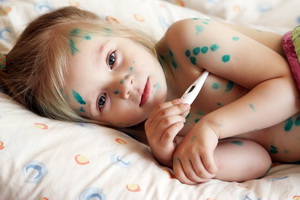
Chickenpox (chicken pox) is a highly infectious acute infectious disease that occurs with a characteristic blistering rash. Children who visit kindergarten or school are more often ill - places with a large number of people.
The disease is caused by one of the herpes viruses. Chicken pox is a very contagious disease. The virus is transmitted from a sick person to a healthy airborne way (during a conversation, staying in one small room). Infection can also occur from a patient with shingles (caused by the same type of herpes virus).
The sick with chickenpox becomes infectious two days before the appearance of the rash, and remains infectious during the first 5-7 days after the appearance of the rash.
The incubation period of chicken pox is 7-21 days. The virus enters the human body through the mucous membranes of the nose, mouth and throat. Then the virus spreads through the body with lymph and blood, penetrates the skin and mucous membranes, where it multiplies. What's happening?
Chickenpox begins with a temperature increase of up to 38ºC, weakness.
On the skin of the face, the scalp, trunk, mucous membranes (in the mouth, on the genital organs), red spots appear up to 5-7 mm in size. A few hours later, blisters form in their place, and then - small, dotted bubbles with transparent contents. After one or two days they are covered with crusts, which, falling off, do not leave a trace.
The appearance of new eruptions (within 3-8 days) and the transformation of individual elements of the rash occur simultaneously - therefore, in one area of the skin you can see spots, blisters, and bubbles and crusts.
The rash is accompanied by severe itching. With each new rash, there is a rise in body temperature, the child's well-being is disturbed. Combing the rashes and ripping off the crusts can lead to infection in the wound and their suppuration.
Complications of chickenpox are rare and are often associated with inaccurate treatment of rashes and their suppuration, which subsequently leads to the formation of scars.
It is extremely rare in weakened children there are severe forms of chickenpox with damage to the brain, internal organs. Similar forms of illness are treated in hospitals, using special therapeutic methods. Diagnosis and treatment Diagnosis is established by the doctor in the presence of information about contact with a sick chickenpox and on the basis of a clinical picture (characteristic rash and general condition).
Treatment of chickenpox is carried out at home. The goal of the treatment is to prevent the suppuration of the vesicles. For this, the greens are perfect, you can use Castellani liquid, an aqueous solution of fucocine or manganese, etc. Children tolerate alcohol solutions very painfully.
From the first day of illness it is necessary to bathe the baby, adding a weak solution of potassium permanganate to the bath. Create the skin of the baby as comfortable as possible: do not wear tight and tight clothes, use only cotton underwear.
If your child is worried about severe itching, tell the doctor about it: he will prescribe antiallergic drugs.
When the temperature rises above 380C, chills, the child must be given antipyretics (paracetamol, ibuprofen).
Afflicted with chickenpox isolated houses for nine days from the onset of the disease. In kindergartens, a 21-day quarantine is established.
Prevention
Vaccines against varicella have not been developed, so vaccinations do not.
Chickenpox is sick once in a lifetime; A person who has suffered a chickenpox in his childhood, can safely communicate with the patient - the virus does not threaten him.


